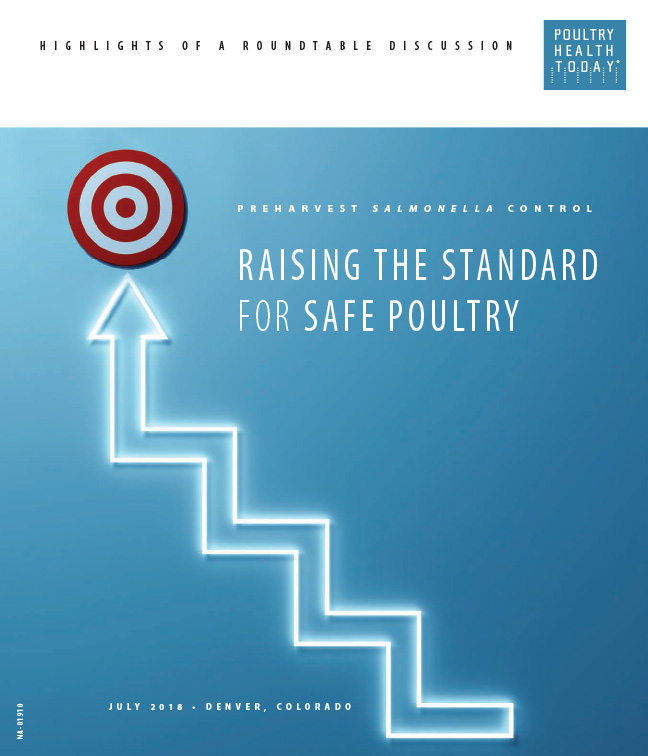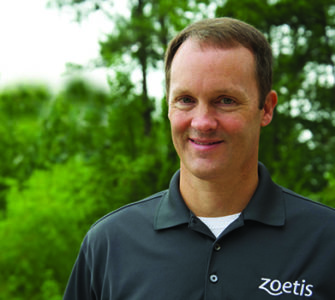Poultry experts identify weak links in live production that can compromise Salmonella control
Improved Salmonella control requires fixing weak links in live production that allow the pathogen to get into a flock, poultry experts advised during an industry roundtable.
The panelists gathered to address preharvest interventions that could reduce the load of Salmonella flowing into processing plants and help poultry companies comply with stricter USDA Food Safety and Inspection Service (FSIS) standards.
The goal for the industry “…is to keep the pathogen load low enough so that processing-plant interventions can work effectively, all the time,” Bruce Stewart-Brown, DVM, Perdue Farms, said at the roundtable Preharvest Salmonella Control: Raising the Standard for Safe Poultry, which was sponsored by Zoetis.
Live-side intervention has to start with pullets and breeders, the panelists said. “In every case of Salmonella I’ve had to deal with, it always started in pullets, then went to the breeders, then the broilers,” said Robert O’Connor, DVM, of Foster Farms.
Charles Hofacre, DVM, PhD, president of Southern Poultry Research Group, Inc., agreed and advised checking out the pullet farm for mouse or darkling beetle infestations. Beetles, he added, get into feed and chicks eat them.
“I’ve worked with farms where we’ve had to completely tear the sidewalls out and the insulation to get rid of the beetles. If you don’t, the next pullet flock will be positive for that farm’s resident Salmonella.”

Bruce Stewart-Brown, DVM, Perdue Farms
Other weak links
Ken Powell, DVM, of Aviagen, said he focuses on feed contamination, rodent control and especially on gut health. “A producer could have an undetectable level of Salmonella; then coccidiosis cycles and amplifies it. You drop the ball on gut health and Salmonella is in every chicken.”
Elizabeth Dale, DVM, of Pilgrim’s, said a slow vertical leak, whether it’s in the embryo or on the shell, is probably the most dangerous. “Then it gets into broilers, and you have a higher number of birds shedding it and the potential for horizontal transmission. But other things — biosecurity or the people involved — are really key regarding other points of introduction.”
Perdue’s Stewart-Brown said ensuring good paw quality should also be viewed as a live-side intervention. “It sounds bizarre. But if you can have consistently good paw health, you generally have pretty dry litter. If you have pretty dry litter, you did a good thing for food safety and for generally containing bacterial contamination.”
He further recommended focusing on farms that have repeat problems with the types of Salmonella that can lead to human illness. “Study the repeating farms, look at them from every angle — rodent control, biosecurity, vaccination, etc. Don’t stop till you break the cycle.”

Ken Powell, DVM, Aviagen
Common serotypes
The most common serotypes associated with human outbreaks over the past 30 years are S. Enteritidis, S. Typhimurium and S. Heidelberg. S. Newport and S. Infantis, as well as other serovars, can also be important in some years, Hofacre said.
Phil Stayer, DVM, Sanderson Farms, said S. Kentucky seems to be prevalent in broilers. Hofacre agreed and noted that it “has a unique ability to out-compete its neighboring Salmonellas.”
Panelists pointed out that USDA’s FSIS does not differentiate between serotypes when rating a plant’s performance. For example, even though S. Kentucky is not a major human-health threat, it still counts against a processing plant if its prevalence is higher than permitted (see sidebar).

Elizabeth Dale, DVM, Pilgrim’s
Vaccination decisions
Noting that most poultry companies were already vaccinating broiler breeders against Salmonella, panel moderator, Jean Sander, DVM, Zoetis, asked panelists about guidelines for vaccinating broilers — a much bigger investment because of the billions of birds involved.
“If I want to lessen the amount of Salmonella coming into the plant, then I’d consider vaccination of broilers,” said Hofacre, also professor emeritus, University of Georgia.
Scott Westall, DVM, of Cobb-Vantress, said another reason would be if there are isolates of concern in the plant. “You might want to use a live vaccine during that time in broilers until you get that isolate incorporated into your autogenous vaccine for breeders.”

Phil Stayer, DVM, Sanderson Farms
O’Connor pointed to research conducted by Hofacre, which has shown that a commercial vaccine does a better job than S. Kentucky outcompeting S. Heidelberg. “That really does justify our use of a commercial vaccine in broilers,” but O’Connor added that “a lot of it comes down to cost.”
He compared a pullet population to “a tiny town,” where it isn’t as costly to vaccinate for Salmonella as it is to vaccinate broiler flocks. “So…it’s expensive to do, but we do it and…we have the science to actually show it’s a preharvest intervention that works,” he said.
Dale said the decision to vaccinate broilers often hinged on the plant’s USDA FSIS category. “Now, if you’re trying to get out of Category 3, you probably need a short-term and a long-term plan. The short-term plan may be throwing everything in the kitchen sink at the problem, but the long-term plan includes a lot more — looking at your management practices, your litter quality and moisture, biosecurity, your pest control, as well as the serovars you have, and testing and vaccination of breeders.”

Kalen Cookson, DVM, Zoetis
Kalen Cookson, DVM, Zoetis, briefly reviewed results from field trials that demonstrated vaccinating broilers against Salmonella with a modified-live vaccine lowered the prevalence of the pathogen at processing. He stressed the importance of making sure vaccination crews vaccinate flocks properly.
Salmonella in conventional versus NAE flocks
Asked if there were differences in Salmonella prevalence between conventional and “no antibiotics ever” (NAE) flocks, panelists said more data are needed to answer that question.
As Perdue moved toward NAE production, Stewart-Brown reported, the prevalence of Salmonella came down. “I’m not necessarily attributing that to the NAE program because we were doing a million other things, which, by the way, I think you do need to do.”
Hofacre believes there is a link between Salmonella and necrotic enteritis, which is often a problem in NAE flocks. “There are ways to keep the bugs that maintain [good] gut health,” he said. “The simplest way is with an antibiotic. The more expensive way to do it is without an antibiotic, and you’re going to have to do a lot of other things to accomplish that.”

Charles Hofacre, DVM, PhD, President, Southern Poultry Research Group, Inc.
Additional measures
Other measures cited by panelists to control Salmonella during live production included water acidification and timing of feed withdrawal.
Sanderson Farms’ Stayer said results with water acidification looked promising sometimes and other times not. “It really depends on where you start — where your water pH is to begin with. It’s not consistent.”
O’Connor said the longer birds are off feed before processing, the more issues there will be with gut health. “You’re going to stress them out, and they’ll shed more Salmonella in the litter right before they’re to be picked up.”
Transport to processing is another major stressor and may be associated with a bigger Salmonella load going into the plant.

Scott Westall, DVM, Cobb-Vantress
Stewart-Brown said Perdue is evaluating new transport vehicles that have features such as better air flow and curtains. “We believe we’ll see a significant benefit with new trailers designed to give birds a higher level of comfort during transport…I’m excited by these developments…[and will] be interested to see if we get improved food safety too.”
Evaluating live-side control efficacy
Methods used by panelists to measure the efficacy of preharvest Salmonella controls varied.
Foster Farms’ O’Connor, for instance, said his company uses boot socks on every farm 2 weeks before processing to look for overall trends. If positive results start creeping up, that indicates there’s a problem.
Dale of Pilgrim’s said, “I still look to the overall Enterobacteriaceae count and the Salmonella prevalence at rehang because that’s as close as I can get to what we’re bringing in from the field…Ultimately, it’s what’s coming in the door of your plant.”

Robert O’Connor, DVM, Foster Farms
Future forecast
Preharvest Salmonella control is important, Dale said, because “…we’re engaged in food production for people.
“Our goal is to produce a safe, affordable, high-quality product,” she continued. “That means we’re inherently engaged in public human health. We’re past the point on the live side where we can simply tell consumers to thoroughly cook their product and wash their knives and cutting boards.”
While better diagnostics, monitoring and vaccines are needed, it’s yet to be determined what interventions will prove to be the most effective, the veterinarian said. Nevertheless, Dale predicted the industry will continue to reduce Salmonella levels and maybe even surpass what it thought was possible.

MODERATOR: Jean Sander, DVM, Zoetis
Hofacre said many companies are searching for new ways to test for Salmonella in live production. “Once we have those tests, we’ll have the opportunity to make more progress on specific farms. I believe that new testing methods will be one of the keys for progress in the future.”
Editor’s note: To download a proceedings booklet with highlights of the roundtable, click here.
Posted on March 5, 2019

















